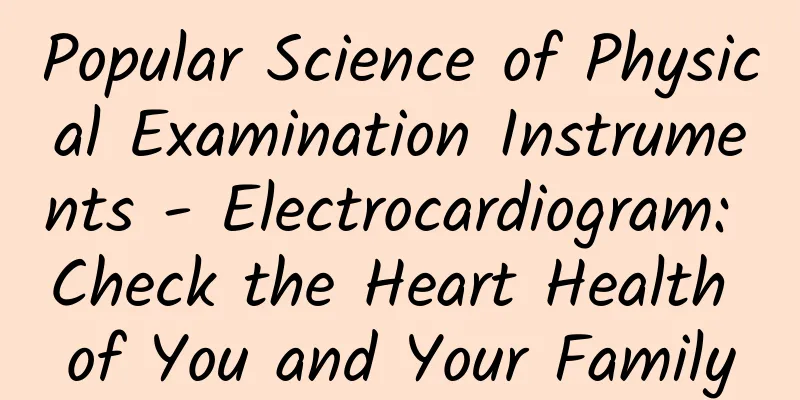Popular Science of Physical Examination Instruments - Electrocardiogram: Check the Heart Health of You and Your Family

|
I wonder if you have ever had a sudden pain in your left chest during your working life this year, which took a long time to heal, as if you were reborn? Do you have trouble breathing after being tired, as if the air is being sucked away by others? Do you have a faster heartbeat after staying up late happily, as if someone is playing a small drum in your chest? Do you feel dizzy, nauseous, and weightless after exercising, as if you went on a bungee jump? If the above situation really occurs, please be sure to go to the hospital to make an appointment for a heart check-up as soon as possible. There are many common heart examinations, and the most essential one is the electrocardiogram, which is a piece of A4-sized paper with twelve uneven lines drawn on it. Electrocardiogram (ECG) sounds familiar but looks confusing. What exactly is an electrocardiogram (ECG)? How do people usually do an ECG? Do we need to pass electricity through the heart to draw these twelve lines? First of all, we need to understand that the heart that beats every day in our chest is composed of myocardial cells. Its job is to promote blood circulation. Why can the heart beat but other organs cannot? This is because heart cells are composed of two parts, one is working cells and the other is autonomic cells. Think of it this way: working cells are the workers themselves, and self-regulating cells are your leaders. Your leaders convey work instructions to you, and you have to work non-stop all day long. The same is true for the heart. Simply put, self-regulating cells transmit electrical signals to working cells, and working cells have to relax and contract every day, working non-stop. And our electrocardiogram is a means of detecting this "instruction". The electrocardiogram records the heart's own electrical activity. The heart is actually always doing electrical activities, emitting electromagnetic waves and transmitting electrical signals. Different electrical signals convey different meanings, and may also indicate potential dangers and problems. This is why we can interpret a lot of pathological information from the electrocardiogram. In my country, electrocardiogram is cheap and a simple piece of paper can reveal many problems. It can be used as a preliminary option for physical examination. By checking whether there are abnormalities in the electrocardiogram, the next examination items can be decided. It is an examination that everyone will choose for a physical examination. Electrocardiograms have many functions. Under what circumstances do we need to do an electrocardiogram? If there is a real problem with the heart and there are clinical manifestations, the electrocardiogram will play a role. If you feel that your heartbeat is too fast or too slow, this is medically considered an arrhythmia, so schedule an electrocardiogram! If you suddenly have difficulty breathing, chest tightness, and nausea, it may be acute heart failure, so schedule an electrocardiogram! If you have palpitations and a significant sense of weightlessness after emotional excitement or exercise, it may be sinus arrhythmia, so schedule an electrocardiogram! If you suddenly have heartache, unbearable pain, and are on the verge of death, it may be a myocardial infarction, so schedule an electrocardiogram! There is another group of people who need to do an electrocardiogram. After taking medications that affect the heart, we need to do an electrocardiogram to detect the effects of the medications on the heart. Even if there is nothing wrong with the heart, we can use an electrocardiogram to reflect the normal heart rate and myocardial condition. Pregnant women must also have an electrocardiogram because the heart burden increases after pregnancy. Regular electrocardiogram examinations can help doctors understand the heart condition of pregnant women. After the electrocardiogram, we got the report. How to understand the electrocardiogram has become a concern for everyone. In fact, there is no need to worry. After the electrocardiogram, the doctor will check the report. After all, the interpretation of the electrocardiogram is a very complicated technology involving various aspects. This kind of professional problem should be left to the doctor! We can also master some common and easy-to-understand terms, such as sinus rhythm written on the report, which is a normal rhythm. All we need to do is to cooperate with the examination as much as possible. There are many precautions before doing an electrocardiogram, so write them down! We need to wear loose clothes before doing an electrocardiogram. After all, we have to take off our clothes to do the examination. If we wear too tight clothes, we can't breathe, which will affect the test results. We cannot wear any metal accessories and tools to avoid affecting the results. We cannot bring our mobile phones with us. We also need to pay attention not to eat too much, not to eat cold food, not to smoke, and not to be on an empty stomach. We need to calm down for 20 minutes before starting the examination. When doing an electrocardiogram, we need to place a clip with a metal sheet on our wrists and ankles respectively; in addition, we need to place 6 small metal balls on our chest. You need to keep breathing calmly, don't talk, don't hold your breath, and relax your mind. |
<<: The "little secret" of children's rehabilitation
Recommend
Health knowledge about menopause
Many female friends are confused about menopause,...
How to reduce prostaglandins for dysmenorrhea
Prostacyclin is an active substance in the human ...
The drug flow is inflamed
Although compared with surgical abortion, medical...
How to solve the problem of bloody vaginal discharge
With the gradual improvement of people's live...
Caesarean section 8 months pregnant
Many mothers get pregnant again soon after giving...
Can I eat goose liver during menstruation?
Goose liver is a favorite choice for many people....
Urethra prolapse after childbirth
After giving birth, there will be many adverse ef...
Is it good for pregnant women to use too many electric blankets?
In our daily life, many people like to use electr...
What to do if rib pain occurs during pregnancy
The happiest thing for a woman is to support the ...
How long does it take to give birth when the cervix is two fingers open and blood is seen
Under normal circumstances, a woman's cervix ...
Great Ways to Reduce Menstrual Pain
Every month women will experience unbearable abdo...
What to eat after childbirth to expel lochia? Scientific diet is needed
There will be a period of lochia discharge after ...
What to do if your breasts swell and hurt when you let milk in
Some breastfeeding friends may experience a tingl...
Is it easy to get pregnant right after menstruation?
Generally, you will not get pregnant right after ...









